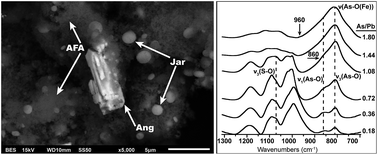Synergistic arsenic(v) and lead(ii) retention on synthetic jarosite. I. Simultaneous structural incorporation behaviour and mechanism†
Abstract
Jarosite [KFe3(SO4)2(OH)6] minerals are effective scavengers of potentially toxic elements (PTEs) and are abundant, for example, in acid rock/mine drainage scenarios. The retention process is highly relevant for environmental attenuation of heavy metals and metalloids since these are usually highly soluble and thus mobile under acidic conditions. We investigated both macroscopically and at the molecular scale the extent and the effects of concomitant incorporation of As(V) and Pb(II) into synthetic jarosite at different As/Pb starting molar ratios, using XRD-Rietveld, SEM, ATR-FTIR spectroscopy and wet chemistry. The amount of arsenate substituted in the jarosite structure was larger when Pb(II) was also incorporated, the former filling up to approximately 33% of the tetrahedral sites normally occupied by SO42−, as compared to 21% when Pb(II) was absent. Similarly, the amount of Pb(II) incorporated in the structure was larger when As(V) was also taken up. The jarosite unit cell volume increased as higher amounts of As(V) incorporated into its structure, but simultaneous Pb(II) incorporation seemed to limit this increase due to its smaller size as compared to K+. The extent to which As and Pb can accommodate in the jarosite structure was found to be limited by concentration maxima under the imposed synthesis conditions. At As/Pb ratios up to 1, Pb–As-jarosites were the only crystalline products. Above this ratio, a mixture of Pb–As-jarosite, anglesite (PbSO4) and poorly-crystalline ferric arsenate (AFA) phases was observed. At the highest As/Pb ratio investigated of 1.80 Pb–As-jarosite was no longer formed. Infrared spectroscopy analysis was applied for the first time here to substituted jarosites with both cations and anions, showing spectral changes in the solids as the As/Pb ratio increased: a characteristic As–O doublet at ∼810 and ∼855 cm−1 was observed upon Pb incorporation, showing an indirect effect of Pb(II) on the As–O bonds in the jarosite structure. Thus, structural incorporation of Pb plays a pivotal role in the unit cell environment of jarosite to balance the distortion caused by AsO4-for-SO4 substitution. The retention processes found in this work have important environmental implications and impacts: through the synergistic incorporation encountered, remediation enhancement of cationic pollutants such as Pb(II) is possible in a concomitant fashion with As(V) attenuation in acidic mining and metallurgical environments.



 Please wait while we load your content...
Please wait while we load your content...